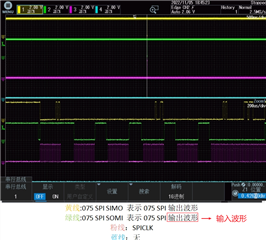Other Parts Discussed in Thread: TMS320F28067
Hi Team,
As shown in the picture, the technical manual didn’t mention that 075 Data must be sent in 16-bit mode with FIFO enabled. But in real tests, when I set SPICHAR=F, the master machine 075 sent a frame of data (0A 00 00 46 00 50) to TMS320F28067, the slave machine. I observed SPIMOSI on the oscilloscope and the waveforms were as follows:

When I only changed SPICHAR=F into SPICHAR=7 (8-bit transmission), left other codes unchanged, and did the same thing as above, the generated waveforms were as follows:

The picture shows that when SPICHAR=7, there was no high-level electricity though there were SPICLK signals. Why did this happen? Was it because other registers (FIFO is enabled) have to make corresponding configuration changes when SPICHAR=7, or because only 16-bit transmission can be sent when SPI FIFO is enabled? If so, there should be relevant instructions in the technical and peripherals user’s manuals. But I didn’t find them.
Best regards,
Katherine

